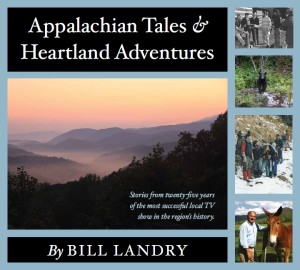
by Bill Landry
The highly-acclaimed memoir by Bill Landry, the voice and face of The Heartland Series on WBIR, Channel 10. The book features 100 stories and 200 photographs about the Series.
Over 25 years, the Heartland team produced 1,900 shorts and 50 half-hour specials, receiving four Emmy awards including two for Landry’s direction
Reviews
November 14, 2011
Bigger Than Expected Crowd Turns Out for Bill Landry
Submitted by J. Paul Mashburn
Bill Landry sold and signed more books than he expected to Saturday. People gathered at the Rocky Top General Store way before the assigned time to begin, so Bill just sat down and started signing.
There was a line already formed when I arrived, and that was at 11:30! The signing wasn’t to begin until noon.
Bill told me and others that he was overwhelmed by the turn out and thanked me for helping him spread the word. “Because of you, people really showed up!”
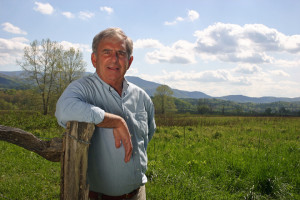 I told him, “No, people came because they love you Bill.” He smiled and seemed pleased.
I told him, “No, people came because they love you Bill.” He smiled and seemed pleased.
So, thanks everyone for making Bill’s day!
September 10, 2011
Bill Landry tells ‘Heartland Series’ stories in new book
by Terry Shaw
Fans of “The Heartland Series” have a chance to read the stories behind the stories that ran for 25 years on WBIR-TV Channel 10 in a new book by host Bill Landry.
“Some of them I may have told 30 times,” Landry said during a recent interview. “But they hadn’t been written down. And everything has to be written down, doesn’t it? Stories. Tales. TV shows. It kind of makes it final and real.”
“Appalachian Tales & Heartland Adventures” (Celtic Cat Publishing) is a 187-page coffee table book full of everything from moonshining to the natural beauty of the Great Smoky Mountains National Park to a tourist who wanted to ride an elk.
It all began in 1984, when Landry was hired by WBIR to do two pilot episodes of the show, created to celebrate the national park’s 50th anniversary. The Chattanooga native figured if they sold, he might have a job for a year or two.
More than 1,900 episodes and four Emmy Awards later, the series was cancelled in 2009.
From the beginning, Landry was paired with videographer Doug Mills, who wrote the book’s forward. “The Heartland Series” was the idea of former WBIR general manager Jim Hart. For many years, Steve Dean served as executive producer. Those colleagues, along with producer/writer Linda Billman, sound man Bill Archer and other staffers appear prominently in the book.
Landry turned to local publisher Jim Johnston with his project. They had met 20 years ago in a church parking lot. Once Landry heard the Belfast-born Johnston’s accent, he asked if he’d like a small part in a Heartland episode.
“I played an inebriated Irishman,” Johnston recalled with a laugh.
Once they reconnected this past January, the two would meet each week, either at Johnston’s Hardin Valley home or at the remote log cabin Landry and his wife Becky built in 2007 in Blount County, next to the national park.
The Landry homestead presented a challenge or two. Once a hailstorm caused Landry’s Internet service to be down for three days. They didn’t have power during another meeting because a bear knocked down a utility pole.
Landry was recently appointed East Tennessee representative on the Tennessee Historical Commission. He also keeps busy “speechifying,” producing, writing and acting. But he said he sometimes misses the show.
“That’s natural, after doing it all those years,” he said. “But we still do four one-hour specials a year. I can see and work with the same folks, and that’s nice.
“Maybe in a way it’s good (that the series was cancelled),” he admitted. “You don’t always know what’s best for you. Doug and I may not have quit.”
Then he laughed.
“And to be honest,” the 62-year-old said, “I don’t feel like hiking eight miles tomorrow to do a moose story.”
Reprinted with permission from Knoxville News Sentinel.
Sam Venable: ‘Heartland’ book sure to please
I feel like the holiday version of a Peeping Tom.
Here we are, three months before the Christmas season is caroling along, yet already I know what throngs of East Tennesseeans will find under their tree – even as the elves labor furiously to finish production.
I feel so certain of this hunch, I’m going to issue a command: Go fetch a pair of scissors right now and cut out this column. Or, if you’re reading online, make a printout. Either way, you’ll have something tangible to stick with your Christmas to-do list. Then you won’t be calling to ask for details later on.
The gem I’m talking about is a book about the late, great “Heartland Series” than ran for 25 years on WBIR-TV. It’s written by a guy who knew the program better than anyone else: host Bill Landry.
“Appalachian Tales & Heartland Adventures” is produced by Knoxville-based Celtic Cat Publishing Co. It’s not on the market yet. But by mid-September, softbound ($25) and hardcover ($45) editions of the 187-page coffee table piece should appear at retail outlets.
I was able to get my hands on a proof copy and spent last weekend immersed in nostalgic pleasure. Trust me: If you liked “The Heartland Series,” you’re going to love this thing.
In warm, laid-back “Landryese” (you can almost hear his familiar voice flow from the pages), Bill travels through the decades: from “ignert” beginnings when the crew bumbled and stumbled into adventure, to full stride when it captivated a vast regional audience and won four Emmy Awards, down to the corporate decision to pull the plug.
It’s packed with behind-the-scenes stories that will sometimes have you howling, sometimes cringing, as the crew explores and videotapes the people, places, customs and lore of Southern Appalachia.
As the more harrowing tales unfold, you’ll realize why Landry always refers to trusted videographer Doug Mills as “Douglas D. Mills – the ‘D’ stands for ‘danger’.” Given the close calls and stress of just-under-the-wire deadlines, you’ll also understand why the show’s in-house moniker soon became “The Heart Attack Series.”
Rarely does an idea come together so well and work for so long as “Heartland.” Credit goes not only to Landry and Mills but also station boss Jim Hart, creative genius Steve Dean, producer Linda Billman, recordist Bill Archer and the many other staffers who turned out an astonishing 1,900 episodes.
As the chapters roll along, Landry often mentions how lucky he and the team were to enjoy such wonderful encounters.
True enough. But we in the audience were even luckier. And now we’re blessed that a quarter-century of iconic memories has been preserved.
Reprinted with permission from Knoxville News Sentinel, in the “Sam Venable” section.
The First Heartland Story: The Bohanan’s
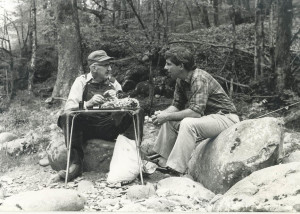 “There were two old guys fishing. We could see them from the bridge. They kept catching trout, one after another. It was pretty cool. They didn’t look like fishermen. They looked like mountain men. And that’s exactly what they were.
“There were two old guys fishing. We could see them from the bridge. They kept catching trout, one after another. It was pretty cool. They didn’t look like fishermen. They looked like mountain men. And that’s exactly what they were.
One was tall and lanky. He wore hip boots. He didn’t have on full body waders that fancy trout fisherman wear. Not this tall drink of water. He was a lean mountain man and wore old school black hip boots that tied to his belt.
The other guy, his brother, was a little heavier and shorter. He fished with two little split shots for weights. He used nymphs and wet flies that sunk the fly down near the bottom of the river, because they always told me that’s where the trout are!
The tall guy used, and this is unbelievable, twelve-pound monofilament fishing line on his fly reel! He had it tied to a little leader, then to two flies separated by a split shot. The flies looked like doodlebugs or big gobs of knitting wool with a little thread around them. Because that’s about what they were: big gobs of wool tied to a huge number 4 or 6 size hook. Boy, did they catch trout!
… That’s when The Heartland Series was born.
… Like he was befriending us, A. D. proceeded to tell us what it was like to grow up in the Great Smoky Mountains. He said, ‘Tell those park rangers, if they want some of these brook trout, tell ’em to go away up in the high mountains and catch some. These trout they got down here, they ain’t brook trout. They’re the rainbow. They got them big heads. Those brook trout got them little bitty heads. These trout down here they’re all mixed up! They’re not the native trout. Now my brother, he’s been here fishing for ’bout sixty-nine years. I reckon he’s been here long enough to be called one of the natives! Ha! Now, we don’t want to argue with no one. Trout’s trout! We like to fish.’
We showed Steve the interview with A. D. and Walter Bohannon… Steve got real excited and completely forgot about the brook trout story for the time being.
‘Here’s the show,’ he said. ‘Listen to what they’re saying. They’re telling you what it was like to grow up in the Great Smoky Mountains! They’re as good as any man and they know it. Listen to how they talk, like they’re sons of these mountains, and they know them because they are!’
It wasn’t so much what they said, but how they said it that Steve was talking about. Quickly, Steve wrote a little introduction for me to say, and we began putting together the story and called it “Fishin’.” It began with me saying something like, ‘I’d like you to meet two new friends of ours, A.D. and Walter Bohanon, streamside philosophers.’
And then, we simply aired the interview and let A.D. talk. We didn’t interrupt him or overwrite the story. This is important: WE LET HIM TELL HIS OWN STORY.”
Tales of the “Tourons”
“One day near Tremont, a lady came up to Kim and asked emphatically, ‘How many trees are there in the Smokies?’
‘Pardon me, madam?’ Kim said.
She insisted all the more. ‘How many trees you got? How many trees are there in the National Park? Don’t you know?’
Once, a lady came up to him in Cades Cove and said, ‘Your fences are loose and your deer are out!’
‘Ma’am,’ Kim said, ‘The deer can jump over those fences.’
‘I don’t care,’ she said, ‘Your fences are broke and your deer are out!’
In Cataloochie, a guy once pointed to a thousand-pound wild elk and said to Kim, ‘Hey, Buddy. What’s it cost to ride one of them?’ ‘You can’t ride it,’ Kim said. ‘It’s an elk!’
‘But I’ll give you ten dollars to ride that elk!’
Ethel Goes to Chicago
“One day Cris Gallu, the current National Sales Manager, came into our office and asked us to put together five or six of our best shows. He said he was going to Chicago to present them to big Execs. ‘The “suits” will all be there; Coca Cola, Toyota, nd the Ford Motor Company!’ He slapped his hands together. ‘We’ll show those boys from the big city about our people, how beautiful it is here. We’ll get this thing sponsored!’
… On Tuesday or Wednesday the following week, we saw Cris and asked him how it went, anticipating perhaps a big raise or, at least the continuation of our jobs for one more year… ‘Boys,’ he said, ‘they loved “The Cow Barn,” and they loved Maynard Ledbetter’s people, and they’d never seen anything in their lives as beautiful as Cades Cove. They loved the mountains and the streams and the people. When Ethel came on and started telling those riddles, hey, they liked that too when she was just sitting there. But when she spit off the front porch . . . Damn,’ he said, ‘Ethel killed us in Chicago!’”
Lenny Garver’s Tale of How to Catch a Bear
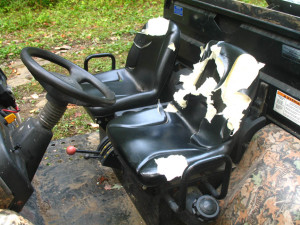 “Lenny giggled as he told us his story. He said, ‘One time, as a teenage boy, I and three of my buddies from in and around here were heading to a big shindig, a dance in Bryson City and boy, were we excited!’
“Lenny giggled as he told us his story. He said, ‘One time, as a teenage boy, I and three of my buddies from in and around here were heading to a big shindig, a dance in Bryson City and boy, were we excited!’
He talked his dad into letting him drive their new car. ‘It was pretty new,’ he said. ‘It was a 1948 Ford, but it had four doors. We called it, ‘the black beauty.’ We were proud of that car, too, especially Daddy.
‘Anyway, we were coming over the mountain that night. My three friends and I were feeling awful good about everything. Coming through that thick laurel, we saw two big bears in there. They were close to the road, too. After the dance, on the way back home, we said, ‘Hey, let’s catch them big bears! Daddy will be so proud of us.’
‘So, on the way out of Bryson City, we stopped and pooled what money we had left and got a steak. We thought we’d catch those bears with that steak! Right where we saw those bears coming over through there, we pulled the car to a stop and opened the trunk and tied a little string to the steak. We hung that steak there dangling for them bears.
‘We’d set a trap in Daddy’s car for the bear! Then, we waited,’ he said. ‘We laid there for about forty minutes or so, ’bout half asleep, when sure enough here come that bear. And he got to sniffing around the trunk of Daddy’s car. And just like we planned, we jumped out of the thicket, pushed that bear into the trunk of Daddy’s car, and slammed the trunk shut. ‘We got him!’ we hollered. Ha. We caught that bear, just like we said we would.
‘Well, sir, we thought how proud Daddy was gonna be that we brung home a big bear. I was thinking just such a thing when we heard this roaring and a’snortin’! And up through the trunk of Daddy’s car, here come that ole bear. He comes right up through the back seat, I’m telling you! And he was a-rippin’ and a-roarin.’
‘You never saw four doors a-flyin’ open any faster in your life! We four fellers jumped out of that car and just left them doors a-swingin’ there. We left the car a-runnin,’ too! Had to! The bear, he tore that car all up. He come right up through the trunk and tore the whole back seat out.’
Lenny just shook his head, remembering. ‘Tore the whole front seat up, too. Tore it all to pieces. It was the worst whippin’ I ever got. Daddy was so mad at me for lettin’ that bear tear up his new car. Ha!’
He looked up. ‘We sure didn’t eat that bear. He got away! We didn’t eat that steak either.’”
The Night of March 31st
“They say that necessity is the mother of invention. I don’t know who “they” are, but it might be the Heartland staff. Because that’s how the April Fools stories came about… While helping with the Friends of the Great Smoky Mountains National Park Telethon, one such idea for a good April Fools show presented itself. At the same time as the telethon was airing, the Park also was reintroducing an elk population into the Cataloochie area in North Carolina.
National Park spokesman, Bob Miller, told us about a call he’d received from a confused and irate taxpayer who was mad as a hornet about the use of American tax dollars to reintroduce elf into the National Park. Yeah, elves! He’d misread an article or heard something wrong. The caller thought the K was an F and elks were elves.
The guy went on and on about it. ‘Name one person who has ever seen a $@*& elf! No one, that’s who! And where you gonna go to get you a pack of elves anyway? Tell me that, huh, if you could find you some!’
The more Bob talked and laughed, the more the wheels in our deranged little minds started to turn. Hee, hee, hee. This one had real possibilities… Amy’s sister happened to work at Seymour Elementary School. Amy contacted them to see if the first graders might be interested in playing elves on a Heartland TV April Fools story. You might as well have asked them if they wanted to meet Santa Claus or have an ice cream party! You bet! They were in. So we had our elves. That was big.
While the first grade at Seymour spent the week making thirty elf costumes complete with little green, Spock-like ears, and tiny shoes that curled up at the toe, we rounded up other elements of the story. We borrowed a big, red cattle truck from Kim Delozier’s father, who just happened to live in Seymour as well.
We contacted cabinet maker, friend, and musician, Buddy Floyd to help us catch the elves. Buddy wore a beard and dressed in a kilt. He played the part of the greatest catcher of Wee People that Ireland had ever produced. Buddy looked great and concocted this fabulous story about being contacted in Ireland by an important man in the U.S. Government to see if he’d help catch the Wee People.
‘They love music and dancing,’ the Great Catcher went on. ‘So at night, as I play music by the fire, the elves begin to dance closer and closer until suddenly I stop playing and reach out and catch them! That’s how you do it!’ It was a masterful performance.
We shot Buddy playing music at night by the campfire on his concertina and reaching into crevasses in the rocks looking for elves. We had wide shots of him in the rolling mountains of Ireland that looked suspiciously like the area around where Buddy lives in Knoxville.
Next, we asked TVA spokesperson and old friend Gil Francis to portray a government beaurocrat. His job was to explain how a K became an F in the proposal, and that it was funded anyway. Gil said emphatically, ‘The government stands behind this project one hundred percent. We’re ready to move forward on it.’
Finally, the big day of the shoot arrived. Mr. Delozier drove up in his enormous, red cattle truck with a huge sign that screamed, “ELF REINTRODUCTION.” Doug got a great shot of the truck going by with the snow-covered mountains in the background. You couldn’t miss the elf sign even if you were asleep.
The camera then cut to the large crowd which had gathered in anticipation, just like the real elk reintroduction scene we saw in Kentucky. They actually were the parents of all the first graders. They came out to help and waved signs that read: “Welcome back Elves,” and “You’ve been gone too long!” and “We love you, Elves!”
Amidst the shouts of “hoorah” stood the lone uniformed Park Ranger, Kim Delozier, bigger than life. In his official Park Ranger hat, he moved toward the truck. As he begins to open the gate, Kim, fights back tears of joy and puts his arm around my shoulder. With our backs to the camera, we’re positioned any minute to see the elves run free.
The Ranger says, ‘Bill. I’ve been working all my life here in the Park for this day! I never thought I’d live to see it. (Sniff, sniff.) You know, it’s nice to know they’re out there, even if you never get to see them!’ … Amidst screams and giggles, the cattle trailer door is finally flung open, and with the sudden force of a landing craft at Normandy, thirty-five elves hit the beach! Finally, the Wee People are set free! Elves are home again in the Smoky Mountains where they belong!
The Moonshiner’s Tale
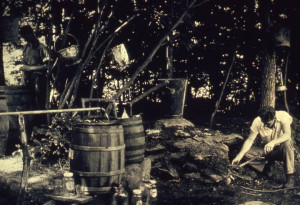 “Eulyss Roberts is the moonshiner we finally chose to talk to. He lived near Oliver Springs at the foot of Windrock Mountain.
“Eulyss Roberts is the moonshiner we finally chose to talk to. He lived near Oliver Springs at the foot of Windrock Mountain.
We heard about him from a friend of a friend of the Assistant Deputy Sheriff of Anderson County. Just far enough back that our sources got a little hazy. Dealing with moonshiners and moonshine, you don’t want to know too much about what’s going on. You have to trust the people you’re dealing with because they trust you. You can’t ask too many questions until you know exactly where you are and who you’re dealing with.
We trusted our sources and found Eulyss, pronounced “you-less.” He lived down an old gravel road in a small house with a sofa on the front porch. The porch ran the length of the house, which had an overhang. When we drove up the road Eulyss was sitting on the old sofa on his porch in his pajamas.
He proceeded to tell us the name of every lawyer, judge, and sheriff in Anderson, Roane, and Morgan Counties that he’d sold liquor to. We always threatened to use that information if we ever needed to!
‘Whiskey’s made to sell. It ain’t made to drink,’ he said. ‘Whiskey’ll ruin the best man in the world. I know. I’ve drunk enough of it to climb a locust tree backerds.’
Eulyss said he’d get up every morning and drink a pint of whiskey. Then, he’d eat a big breakfast and go to the coal mines. About 10:30 he’d get to shaking so bad he’d drink another pint. He said it took him thirty-five years to find out what it was doing to him, and when he did, he quit it.
He said he made a batch one time and, as he was running it through the still, something went wrong. ‘Something got clogged up in the worm, and the thump keg got to rattlin’ real bad,’ he said, ‘so I jumped up on the thump keg and directly, Poof!’ He made a sound to simulate the air blowing through a pipe or something.
He said, ‘The next day when I went to dump out the old mash and clean out everything, as I turned the keg over, I looked up and seen this mouse’s head roll out of the mash leavins. Its eyeball was hanging out from the side of its head. It was the sickest thing I’d ever seen.’
‘What did you do with the whiskey?’ I asked.
‘Sold it,’ he said. Then he added quickly, ‘It ain’t made to drink. It’s made to sell.’